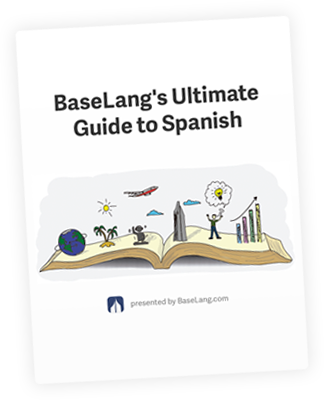Adonde vs Donde: Differences and Uses in Spanish

Get our free email course, Shortcut to Conversational.
Have conversations faster, understand people when they speak fast, and other tested tips to learn faster.
More infoIn Spanish, we have diverse words and expressions when referring to places or locations. In this post, we’ll see the difference between adonde vs donde and adónde vs dónde. Although these words sound pretty similar, their meanings in Spanish are not the same.
In this post we’ll go through the meanings of adonde and donde, when to use the accent to form adónde and dónde, as well as their differences and uses.
Adonde, donde, adónde, and dónde can all be translated as where in English. But in Spanish, we cannot interchange them. Each word has a distinct meaning and a different function depending on where they’re used in a sentence and whether they have the written accent.
Let’s dive in and take a look at all the details between the different forms of donde vs adonde!
Donde and Dónde
We’ll start off with these two Spanish where words without the initial “a.” The key detail here is that donde and dónde are generally used to talk about static locations, rather than implying some movement to a destination. Let’s see what we mean here for each of them.
Dónde
Dónde with an accent mark is a Spanish question word, or interrogative. This version of where in Spanish is used to ask questions about the location of an object, person, or place. We always use the opening question mark ¿ when asking questions in Spanish, including with dónde.
For more details on the use of Spanish question words, and for an introduction to the other ones, check out our dedicated post on question words in Spanish.
- ¿Sabes dónde queda el centro comercial? – Do you know where the mall is?
- ¿De dónde es tu prima? – Where is your cousin from?
- ¿Dónde está el dinero? – Where is the money?
You can also find the accented question word dónde in indirect questions, or in statements that are similar to responses to a question:
- No tengo idea de dónde vino ese bicho. – I’ve no idea where that bug came from.
- Me pidió que le indicara dónde era la fiesta. – He asked me to tell him where the party was.
Donde
In the case of donde, we use it as an adverb when we want to refer to a location or place.
- Tu cuaderno está donde lo dejaste ayer. – Your notebook is where you left it yesterday.
- Esta es la casa donde nació mi abuela. – This is the house where my grandma was born.
- Estamos en un lugar donde podemos nadar. – We are at a place where we can swim.
Donde has another use that is very common in colloquial speech. In this case, our donde meaning is someone’s house or place.
- Fui donde Roxana. – I went to Roxana’s house.
Dónde vs donde
As we’ve seen here, these two words are quite similar, with their main differentiation being grammatical. Dónde is always used as a spanish interrogative, both in direct and indirect questions. On the other hand, donde without the accent is used as a Spanish adverb, used to describe where something is or was. Donde is also used informally to refer to someone’s place.
Adonde and Adónde
Our other two words for where in Spanish both begin with “a.” The key point to remember with adónde and adonde is that there’s some implied destination. A good way to think of adónde and adonde in English is as where to or to where, even if in English you often omit the to.
In fact, in Spanish the words adónde and adonde can both actually be written as two separate words: a dónde and a donde. This may help you remember that the English translation should be to where, even if it may seem confusing to have different options in Spanish! In this lesson we’ll just keep the a attached to all our examples, but at least you know the separated form exists.
Adónde
Adónde with the accent mark is another of our Spanish interrogatives used to ask questions and to form exclamations. We use adónde to ask where to. You know to use adónde over dónde when there’s some movement involved, or when the answer should include a destination.
Remember that like other question words in Spanish, adónde always triggers the use of the opening and closing question marks when asking questions, and always has the accent.
- ¿Adónde vamos a cenar esta noche? – Where are we going for dinner tonight?
- ¡Adónde iremos a parar con esta inflación! – Where are we going to end up with this inflation!
- ¿Adónde se fue tu hermana? – Where did your sister go [to]?
You can also find adónde with a stress mark in indirect questions, or in statements that are clearly formed inquisitively like a question.
- Dime adónde vamos a ir. – Tell me where we are going to go.
- No sé adónde pueden haber ido los niños. – I don’t know where the kids may have gone [to].
Adonde
Adonde is an adverb of place that indicates movement or destination. We generally use it with the verb ir (to go) or any other verb of movement. Adonde is usually translated into English as where [to].
- El lugar adonde vamos a ir es muy bello. – The place where we are going to go [to] is very beautiful.
- El pueblo adonde se dirigen está muy lejos de aquí. – The town where they’re heading [to] is so far away from here.
- Vamos a viajar adonde tú quieras. – We are going to travel where you want to travel [to].
Adónde vs adonde
Both adónde and adonde indicate some movement or a destination, and can generally be translated into English by including to along with where. Adónde is a question word, while adonde is used in statements.
Conclusion: Adonde vs Donde vs Adónde vs Dónde
So far we’ve gone over each of these four Spanish where words individually, so let’s just have a quick recap on how the different variations are similar and different:
Without the accents: Donde and adonde are both adverbs that we use to talk about places in Spanish.
With the accents: Dónde and adónde are both interrogatives, used to ask direct or indirect questions or exclamations.
Without the initial a: Donde and dónde are used to talk about a static location.
With the initial a: Adonde and adónde are used to talk about movement or a destination.
That’s about it! Hopefully the similarities and differences are clear now, so you’re ready to use the right word when you need to say where in Spanish. It all comes down to whether there’s movement to a destination or not, and whether you’re asking a question. Got it? Great! Then we’ll leave you with a few exercises so you can practice between using adonde vs donde vs adónde vs dónde!
Exercises
Complete the sentences by choosing between adonde, donde, adónde, or dónde.
1. Aquí es ______ hay los mejores vinos del mundo.
2. No estoy seguro ______ vamos a ir mañana.
3. ¿______ está el museo de arte moderno?
4. El perro está ______ está tu hermano.
5. ¿______ vamos a ir de vacaciones el verano próximo?
6. La montaña ______ vamos es muy alta.
7. ¿______ queda la biblioteca del pueblo?
8. ¿______ vas Juan?
9. No sé ______ lleva Pedro esos libros.
10. ¿______ se están mudando?
Answers
1. Aquí es donde hay los mejores vinos del mundo. – Here is where the best wines of the world are.
2. No estoy seguro adónde vamos a ir mañana. – I’m not sure where we are going to go tomorrow.
3. ¿Dónde está el museo de arte moderno? – Where is the museum of modern art?
4. El perro está donde está tu hermano. – The dog is where your brother is.
5. ¿Adónde vamos a ir de vacaciones el verano próximo? – Where are we going to go [to] on vacation next summer?
6. La montaña adonde vamos es muy alta. – The mountain where we are going [to] is very tall.
7. ¿Dónde queda la biblioteca del pueblo? – Where is the town library?
8. ¿Adónde vas Juan? – Where are you going [to], Juan?
9. No sé dónde lleva Pedro esos libros. – I don’t know where Pedro is taking those books.
10. ¿Adónde se están mudando? – Where are you moving [to]?




